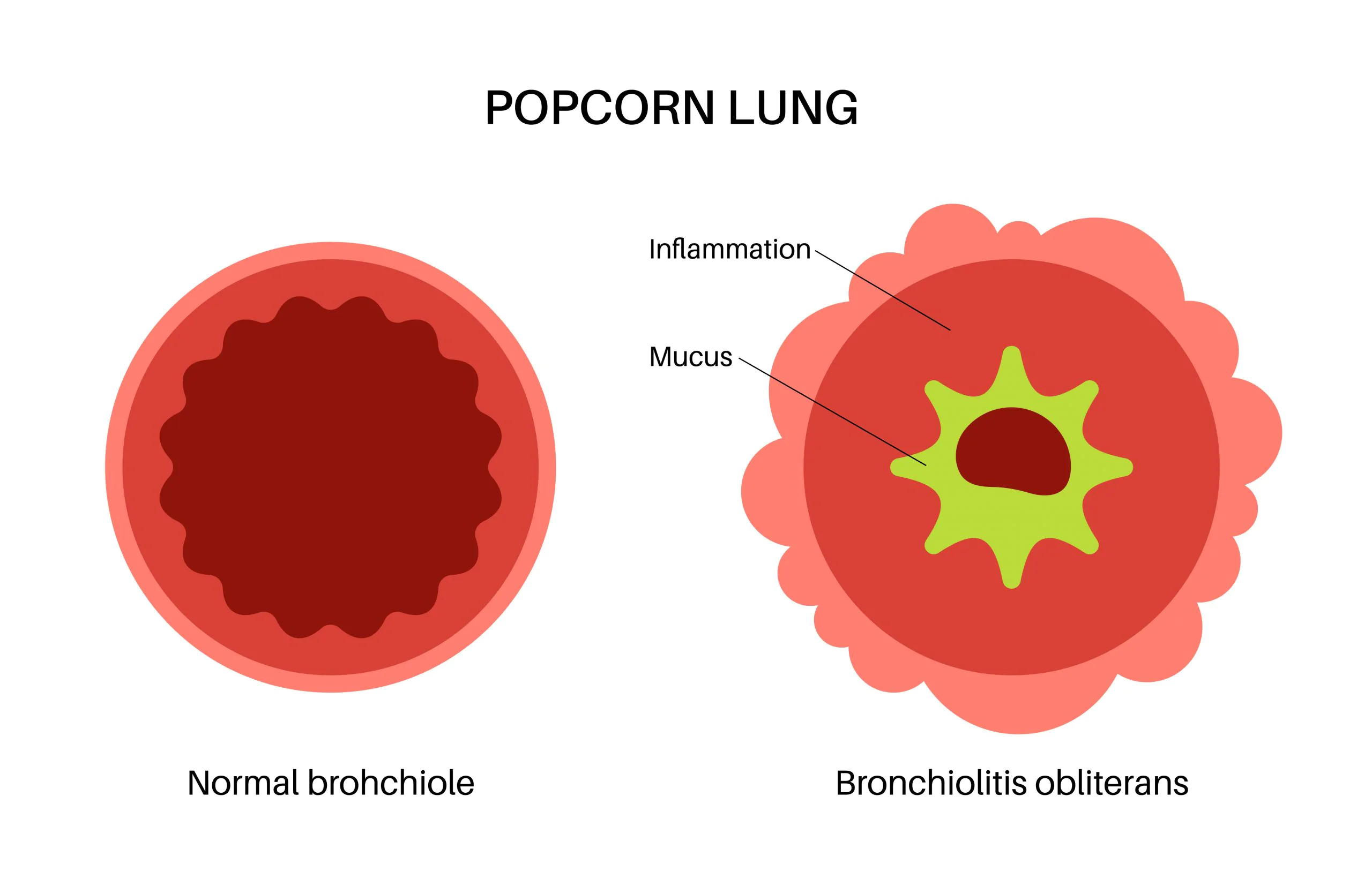The lungs operate through a network of branches, each contributing to the flow of oxygen into the body. The smallest of the branches are the bronchioles, which are connected at their base to the alveoli or air sacs. As the name suggests, the air sacs are where the blood picks up oxygen.
This system works well—without human intervention—unless the bronchioles are injured or exposed to harmful chemicals, which can occur when smoking electronic cigarettes, commonly called vaping. Then thick scar tissue may build up, causing the bronchioles to narrow. The result can be a blockage: Air will not reach the alveoli, and ultimately the bloodstream.
What is Popcorn Lung?
Popcorn lung is a rare but life-threatening respiratory disease known in medical textbooks as bronchiolitis obliterans. It is a chronic disease that disrupts the flow of oxygen in the body.
Potential Respiratory Failure
According to the American Lung Association, respiratory failure can result from vaping. What’s more popcorn lung is irreversible, says the Centers for Disease Control and Prevention. In extreme cases, a lung transplant may be recommended if steroids and other treatments fall short.
What Causes Popcorn Lung?
The term ‘popcorn lung’ originated in the late 1990’s and early 2000’s when a wave of illness at a microwave popcorn factory occured in the U.S. Many workers got severely ill after breathing in the buttery-sweet food addictive known as diacetyl. Hundreds of cases of bronchiolitis obliterans, some fatal, were tied to this chemical used to flavor popcorn, dairy, and caramel.
Studies in rodents confirm that diacetyl vapors can damage the cells lining the airways, says the National Institute for Safety and Health. Major factories stopped using diacetyl, but the story doesn’t end there.
Diacetyl continues to cause popcorn lung today in connection with electronic or e-cigarettes. Preferred by some because they don’t use cancer-causing tar like traditional cigarettes. Electronic cigarettes depend on a battery-powered device that heats a tank or cartridge of liquid that may include flavorings, and other chemicals.
A federal ban in 2020 addressed flavored e-cigarettes that may contain diacetyl, like the cartridge or pre-filled pod devices sold by JUUL.
Because of the health risks, New York State became the first state to act against flavored cigarettes with Governor Andrew Cuomo’s executive order in 2019. A ban on e-cigarette flavoring is also part of the fiscal year 2021 budget. Despite these bans, inhaling diacetyl is still a risk when vaping.
More Vaping Chemicals Associated with Popcorn Lung
Besides diacetyl, the following chemicals associated with vaping are also linked to popcorn lung:
- Acetaldehyde, AKA Ethanal: A colorful and volatile liquid found in the smoke of marijuana and some e-cigarettes.
- Formaldehyde: A known carcinogen, formaldehyde in e-cigarettes is linked to popcorn lung, says WebMD. It is also common to glues and building materials.
- 2.3-Pentandione: Sometimes used as a substitute for diacetyl, this flavoring has been linked to respiratory illness in lab tests, according to the U.S. Occupational Safety and Health Administration.
Not only are these chemicals dangerous, but their connection to vaping, which directly involves the lungs, puts the e-cigarette user at particular risk. Since vaping can turn into a daily habit, the risk is compounded just as it was for the workers who breathed in diacetyl on a regular basis.
Other Chemicals Linked to Popcorn Lung
Beyond vaping, these chemicals can result in popcorn lung:
- Sulfur Dioxide and Nitrogen Oxide: Burning fuel goes off these chemicals.
- Ammonia and Chlorine: Everyday products sometimes used for cleaning
- Metal Oxide Fumes: A byproduct of welding
- Sulfur Mustard: A chemical weapon that also goes by the name mustard gas
- Hydrochloric Acid: Used in industrial processes like the removal of rust
It should be noted that besides exposure to chemicals, popcorn lung can result from medical conditions like pneumonia, bronchitis, rheumatoid arthritis, or certain transplants including lung and bone marrow.
Symptoms of Popcorn Lung
According to the American Lung Association, the symptoms of this disease can vary and have been likened to those experienced with chronic obstructive pulmonary disease (COPD).
The most common symptoms of popcorn lung are as follows:
- Shortness of breath
- Dry cough
- Wheezing unrelated to a cold or asthma
- Fatigue
- Possible skin rash
Symptoms may appear an estimated two weeks to two months after exposure. These symptoms may include flareups that occur during exercise or physical work activities. As the branches in the lungs become increasingly clogged, these symptoms are likely to intensify.
Popcorn Lung Statistics in New York
Popcorn lung is a rare disease with no statistics readily at hand. There are figures available, however, from the Centers for Disease Control and Prevention for the complete spectrum of lung injuries related to vaping and electronic cigarettes. It is possible that these illnesses also include popcorn lung.
As of Feb. 18, 2020, there have been a total of 2,807 hospitalizations and/or deaths reported from vape-and-e-cigarette-related lung injuries throughout the U.S., the District of Columbia, Puerto Rico, and the Virgin Islands. During this period, 68 deaths were confirmed.
In New York, the Department of Health reported a total of 165 patients from all regions of the state with such respiratory ailments, including one death, as of early November 2019.
The majority —62 percent, according to the New York Department of Health (NYDOH)— of these patients were under the age of 25. And, according to the DOH, the vaping danger to youths is growing. A significant increase in e-cigarette use (160 percent) was reported among New York high school students from 2014 to 2018.
Can You Sue for Popcorn Lung?
When a product causes illness, as is the suspected case with electronic cigarettes and popcorn lung, victims can sue in civil court.
There are a few avenues to take with legal action, based on the circumstances and a skilled attorney’s recommendations, such as wrongful death and product liability lawsuits.
A wrongful death lawsuit is based on an act or omission that leads to someone’s death. In New York, this action must be filed by the personal representative of the deceased’s estate. This representative doesn’t have to be a family member, but they must oversee the estate. Regardless, the heirs can still benefit from any award.
The first wrongful death case associated with vaping was filed by a Florida teenager’s mom in 2019 after she lost her 18-year-old son to breathing and lung issues. She alleged that vaping advertisements her son saw at age 15 drew him into the habit that eventually took his life through nicotine addiction.
A product liability lawsuit is a specific type of personal injury case. Each consumer has certain expectations regarding product use; the law allows for legal action when a product introduces an unanticipated risk.
In cases where someone dies from popcorn lung or another respiratory illness triggered by vaping, a product liability suit could be filed against the manufacturer and any others associated with the product and its distribution.
Those responsible for a defective product may include:
- The manufacturer of the product or its parts
- The store, wholesale supplier, or distributor of the defective product
- The party that assembles the product
The lawsuit may be based on the following:
- Manufacturing flaws
- Deceptive marketing
- Inadequate warnings or instructions.
- Design defects
Negligence and Product Liability
For those filing a product liability claim, there is no need to prove negligence as with a typical personal injury case.
According to NOLO, a legal resource, the person filing the suit will have to prove the following:
- That they were injured.
- That the product was defective.
- That the defect caused the illness.
- That the victim used the product as intended.
Statute of Limitations for Popcorn Lung
Each state has their own time limit for filing a product liability case. In New York, the time limit, a.k.a. statute of limitations, is three years from the time the illness was discovered. With popcorn lung, the clock may not start running until symptoms present themselves or there is a diagnosis.
Lawsuits Escalating Over E-Cigarette Impact
According to the consumer group Drugwatch, lawsuits against the makers of e-cigarettes are growing in number and totaled at least 758 nationwide as of July 22, 2020.
With e-cigarettes, lawsuits have cited a potential marketing defect, alleging that advertisements target minors. For example, in 2019, New York sued JUUL Labs on grounds that included marketing to youths and not clearly disclosing its nicotine connection.
Popcorn Lung Settlements in New York
Below is an example of a popcorn lung settlement won in New York:
Consumer Award Tops $7 million
In 2016, the first consumer diagnosed with popcorn lung in relation to the buttery flavor addictive diacetyl was awarded $7.2 million in damages. Alleging the microwave popcorn he purchased had no warning labels, the Colorado man’s lawsuit included both the manufacturer and the supermarket.
Sobo & Sobo does not cite actual settlement values for our clients’ cases, even anonymously, for reasons of privacy. From time to time we may include publicly available individual case histories and ranges of general, US settlement values that are published by reliable sources. These, however, should not be interpreted as representing Sobo & Sobo cases or suggest future outcomes at Sobo & Sobo.
Personal Injury Attorneys Ready to Help
New York-based Sobo & Sobo is experienced in all types of personal injury cases including product liability. Consultations are free, and there is never any fees owed unless we win. You only pay with a portion of their settlement, which means that Sobo & Sobo clients never owe us money out of pocket.
Call 855-468-7626 or contact us online to schedule your free initial consultation today.




